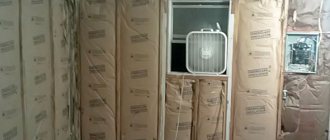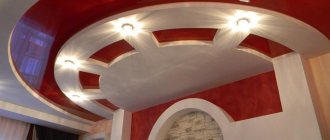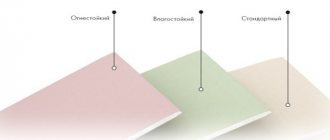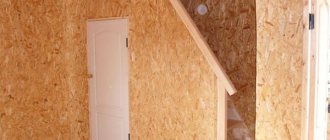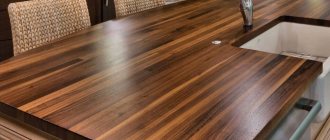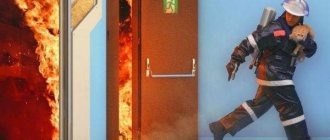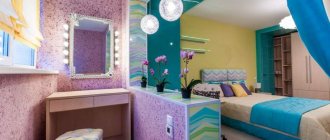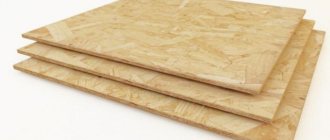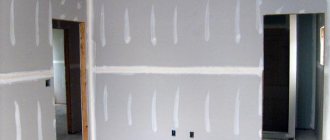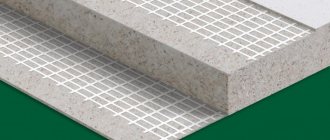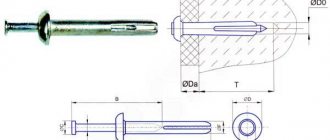Kamila_Feodosya
13469 0 6
Kamila_Feodosya September 27, 2016Specialization: professional approach to architecture, design and construction of private houses and cottages, new products on the market of building materials and finishing. Hobbies: growing fruit trees and roses. Breeding rabbits for meat and decorative breeds.
Original designs from gypsum plasterboard
In order to make sure that drywall is harmless, you first need to find out what this material is made of. Sometimes on the Internet you can find simply crazy statements about the enormous harm of this convenient type of finishing. “Drywall is harmful to health,” write people who are little familiar with this building material.
But for some reason, everyone calmly allows themselves to be put in a cast for a fracture and does not worry about its harm to the body.
Is drywall harmful to health - the whole truth and myths
Original designs from gypsum plasterboard
In order to make sure that drywall is harmless, first of all you need to find out what this material is made of. Sometimes on the Internet you can find simply crazy statements about the enormous harm of this convenient type of finishing. “Drywall is harmful to health,” write people who are little familiar with this building material.
But for some reason, everyone calmly allows themselves to be put in a cast for a fracture and does not worry about its harm to the body.
Composition, production and features of plasterboard sheets
Types and markings of plasterboard sheets
Only three components are involved in the production of gypsum board sheets - gypsum, cardboard and water. The production principle is simple and clear. There is a gypsum layer between two sheets of thick cardboard. Basically, that's it.
Gypsum has been used in construction for thousands of years, and until now there has been no harmful effect on the human body.
Gypsum is obtained by processing sedimentary rock. So pure gypsum is an absolutely natural material.
Cardboard, as you know, is a wood processing product, also a natural component. So if gypsum board is produced in strict compliance with all standards and technological processes, then it is absolutely safe.
Safety is on the conscience of the manufacturer
The bathroom only needs waterproof drywall
However, the “hand of the market” dictates its conditions, and in pursuit of large profits, many manufacturers try to save on consumables or bypass some expensive production cycles. And in this case, the answer to the question whether drywall is harmful or not should be addressed to the manufacturer.
What tricks do building material manufacturers resort to to reduce material costs? For example:
- The use of low quality gypsum with a high percentage of impurities and debris. In this case, the strength of gypsum board sheets decreases significantly. And the composition of impurities can only be determined in the laboratory. Therefore, it is worth purchasing building materials from proven and reliable reputable manufacturers.
Do-it-yourself partitions are easy
- In order to increase the strength of low-quality gypsum, chemical additives and additives can be used, the price of which is much lower than the cost of high-quality pure gypsum.
- Sheets of waterproof and fire-resistant gypsum board are treated with special water-repellent and fire-retardant impregnations. Therefore, chemical components are present in the material in this case. But if a conscientious manufacturer complies with GOSTs and uses approved additives, then the “businessman” will use cheaper, and, therefore, less safe impregnations.
But drywall in the house can still be harmful to health. Not as a building material in itself, but as a source of the formation of fungus and mold if installed incorrectly .
Sometimes claims against a material are caused by improper operation and illiterate application, illiterate installation, which does not take into account the technical characteristics and properties of the material.
Features of gypsum plasterboards that can cause unpleasant consequences
In the photo - installation of gypsum boards on a slope without a frame
Is drywall harmful in an apartment? Yes, if installed incorrectly. First of all, it is necessary to take into account that gypsum perfectly absorbs moisture and not only that which directly falls on the sheet, but also moisture from the air.
Therefore, very often you can observe fungus and mold in the corners of a room that is sheathed with gypsum plasterboard without complying with the norms and building regulations.
Basic rules for installing gypsum boards:
- Ideally, drywall should be mounted on a metal sheathing , but in some cases it is possible to cladding directly on the walls using the Ceresit adhesive mixture.
- I very often listened to complaints about the appearance of fungus and asked the same question - were the walls primed ? Almost always the answer was no, but why?
The walls must be primed
- Before installing the sheathing, the wall must be treated with a deep penetration antiseptic impregnation . Since often in places where cold bridges form on the wall, moisture accumulates and fungus and mold appear.
- When installing over the sheathing, the voids between the wall and the sheathing must be filled with insulation . You can use mineral wool, polystyrene foam or natural insulation based on hemp or flax.
Installation on metal lathing
- Sagging sheets on the ceiling and waves appear due to too large a pitch of the sheathing, as a result of cracks and deformation of the entire structure.
- If the joints between the sheets are not puttied using a reinforcing mesh, then cracks will certainly appear, followed by fungus and mold. Especially when installing drywall with your own hands, pay attention to carefully sealing all joints and places where the sheet adheres to the walls.
- You cannot install regular gypsum boards in bathrooms and toilets, as well as in the kitchen, where there is a lot of water vapor.
- The instructions require proper storage of the material. If you don’t follow the rules, your brand new cladding may be ruined within a week. The sheets must lie in the room where they will be installed to acquire the same humidity. When the gypsum board dries suddenly and gets wet, it cracks.
It is important to remember that plaster instantly absorbs moisture, so any harmful fumes will remain in the finish forever.
Mold on window slopes
- If the slopes get wet due to poor ventilation and waterproofing, then the fungus will immediately spread to the finishing.
In a residential building, cladding walls and ceilings with gypsum plasterboard is harmless, but only if it is carried out in compliance with all installation standards and regulations.
Benefits of drywall
Ideal insulation and the possibility of any finishing
We found out why this material is harmful. But the same qualities that can cause harm also give drywall a lot of advantages:
- The room maintains an excellent microclimate and comfortable humidity , since the properties of gypsum plasterboard allow you to both take excess moisture from the air and release it as needed.
- The material is 100 percent natural and approved for use in residential construction by the Ministry of Health.
- Installation over lathing allows you to additionally insulate the walls and organize high-quality ventilation under the finishing.
Gypsum production business
Underground mining of gypsum stone is widely used in large enterprises located in areas where gypsum stones are located. To extract rock underground, autonomous chambers are used, with the help of which only what is needed to make gypsum is extracted from the entire rock. Also, to select the necessary material and clean the workplace, the following equipment is used:
You must prepare copies of the passports and TIN of the business organizers, the company’s constituent documents, pay the state fee and write a corresponding application to the Federal Tax Service. Another important point! Do not forget that a code is provided for this industry, according to the All-Russian classifier, it is OKVED 26.53 .
“During the prosecutor’s audit, a legal assessment will be given to the actions of the organization’s officials in terms of compliance with labor protection requirements. Based on the results of supervisory activities, if there are grounds, a set of prosecutorial response measures will be taken,” said an employee of the prosecutor’s office.
“All technical and fire safety requirements on the plant territory are complied with without fail. Safety briefings are carried out regularly, in accordance with established standards. Today’s incident is an accident,” Dzhantemirov said, adding that the plant will provide financial support to the family of the deceased.
Is drywall harmful to health: truth and fiction
When planning repair and finishing work, many of us carefully study the characteristics of all materials used, in particular plasterboard used for cladding walls and ceilings. And in the course of such a study, the question naturally arises: is drywall harmful to health?
Rumors about the harm that plasterboard sheathing can cause to human health are circulating quite actively. In this article we will try to figure out whether there is any truth to these rumors.
If everything is done correctly, the harm will be minimal
The oldest building materials are leaders in environmental friendliness
No matter how unusual, strange, or unacceptable it may seem, in first place among the environmental friendliness of wall materials is... wheat straw . Moreover, some varieties of wheat began to be grown primarily not for the grain, but for the stem.
In Russia, “straw” construction also began. Thus, the Moscow LLC Sereda builds thatched houses and organizes training seminars.
In second place in the ecological series is raw (unfired) clay . The majority of the world's population once lived in dwellings whose walls were made of this material; at least a quarter now live in them. And, most interestingly, the share of clay houses has begun to grow in recent years, primarily in the most developed countries.
Note. In developed countries, the construction of housing made of straw and unbaked clay is rapidly increasing. Obviously, the fashion for such houses will soon come to Russia.
Recently, studies have been conducted on the health effects of clay housing. It has been reliably established that even a half-hour stay of a person in a “clay” room leads to an improvement in his well-being. Taking this into account, as well as the cheapness of clay, clay house construction is currently beginning to develop in many, and by no means the poorest, countries (England, Germany). And in the capital of Austria, Vienna, a seven-story (!) building was built from clay.
In third place in the ecological series is wood. The environmental friendliness of its dwellings requires no comment. However, even for our country, which is by no means treeless, wood is a very expensive building material, so not all Russians manage to live in wooden houses.
The desire to live in houses that are at least close to wooden ones in terms of environmental friendliness encourages the use of wood in the form of waste - sawdust, shavings, crushed wood - for the production of wall materials. For these purposes, arbolite (literally translated from French-Greek as “wooden stone”), obtained from a mixture of crushed wood with Portland cement, xylolite (also “wood-stone” in literal translation from Greek), obtained from a mixture of sawdust, other fine wood and magnesium cement.
General information about drywall
Drywall composition
Structure of plasterboard sheet
To understand how harmful drywall is to health, it is necessary to study the composition of this material in as much detail as possible.
So, what is drywall?
- The basis of drywall is building gypsum - a natural material obtained by firing at 1800 and then grinding.
- In addition to gypsum, the filler may include starch, PVA glue, fiberglass, etc.
- The hardened gypsum is placed between two layers of thick cardboard, which acts as reinforcement. According to GOST 8740-85, cardboard sheets with a density of 0.17 to 0.22 kg/m2 are used for the production of construction plasterboard.
- The edges of the cardboard are folded around the ends of the plasterboard sheet, forming a securely protected edge. The main function of this edge is to protect the drywall during storage and transportation.
Types of drywall
Today, the building material market offers several varieties of plasterboard finishing boards.
They are distinguished from each other by their composition, performance characteristics, and price: as a rule, drywall with additional properties is more expensive than the standard one.
- GKL - standard drywall . The surface of such drywall is made of gray cardboard, the markings are applied with blue paint. A standard plasterboard sheet does not contain substances harmful to human health and can be used for interior decoration of rooms with normal humidity.
- GKLV is a moisture-resistant material . The cardboard shell is impregnated with waterproof mixtures and an antifungal compound, which prevents the drywall from getting wet. This type of drywall is made green (the appearance is shown in the photo) and is used in rooms with high humidity - bathrooms, etc.
- GKLO – fire-resistant plasterboard sheet . The gypsum filler contains reinforcing fiberglass additives, so when the cardboard layer burns out, the plasterboard sheathing sinteres and retains its structure. Even when burning, it does not emit toxic substances (except, of course, carbon monoxide).
- GKLVO is a combined material that combines resistance to high temperatures and wetness. Like previous varieties, it does not contain toxins or heavy metals.
As you can see, there is nothing in the composition of high-quality (i.e., produced in accordance with GOST requirements) plasterboard that could cause plasterboard to be harmful. Still, in some situations, plasterboard sheathing can cause health problems.
Practical tips on how to reduce damage from drywall
- Drywall is not recommended for use in closed, unventilated spaces with higher than normal humidity levels. For cladding or finishing baths, saunas, showers, and Jacuzzis, it is better to use another building material with high water-repellent characteristics. The use of dry plaster for covering a suspended ceiling in such rooms is especially not recommended. As the material swells, it sags, becomes deformed, and can collapse the entire structure.
- For the construction or finishing of attic floors and outbuildings, fire-resistant plasterboard with guaranteed resistance to high temperatures is used.
- When purchasing sheets, make sure there are markings on each unit. Factory material has a blue mark. If there is no inscription on the surface or it is written in faded pencil, refuse the product. Most likely, it was produced without complying with GOST, is not certified, or is made of poor quality.
- Seal the seams at the junction with a special ready-made mortar intended for interior work in residential premises. Otherwise, you will end up with a source of release of harmful substances while the drywall is completely harmless.
- The best material for sealing seams is elastic putty. It prevents the formation of a defective area in the structure when the temperature changes, and therefore eliminates the possibility of the formation of mycotoxins.
- By carefully sealing the seam, they provide sound insulation, remove the source of moisture penetration into the seam joints and prevent fungal infection of the base.
- Technical drywall has an appearance similar to conventional dry plaster. The difference is in the core between the sheets. Poorly processed gypsum is used for technical products. The surface of the leaf disperses microscopic dust particles into the air. Constantly staying in a room decorated with such material contributes to an allergic reaction, redness of the eyelids, and nasopharyngeal congestion. It is recommended to use this type of drywall in non-residential rooms.
- In a well-ventilated room, drywall acts as a humidity regulator. The porous surface absorbs excess moisture, and when the composition of the air changes, it begins to release water vapor into the surrounding space. Plan a good ventilation system, and dry plaster will serve not only for decoration, but also for natural moistening or drying.
- When installing partitions, openings, and plasterboard arches, carefully select the surface dye. It must match the technical characteristics of dry plaster and not change its porous structure.
Harmful effects of drywall
When can drywall be harmful to your health?
Cutting may generate dust
When deciding whether drywall is harmful to humans, you need to pay attention not only to the composition of this material, but also to the conditions in which the material will be used. And here are several pitfalls that need to be taken into account.
So, why is drywall harmful?
- Firstly, when working with drywall, gypsum dust is released, which, like any other dust, poses a danger to the human respiratory system . Systematic inhalation of gypsum dust can cause irritation of the mucous membranes and also provoke the development of respiratory diseases.
Advice! To prevent exposure to gypsum dust on the body, all work on sawing and drilling plasterboard sheets must be carried out in personal protective equipment. After completion of work, the resulting dust must be removed immediately.
Mold on slopes
- Secondly, ordinary drywall has a porous structure, and when moistened it becomes a substrate favorable for the development of mold fungi . It is fungal infections that often underlie ideas about how harmful drywall is to health.
- Most often, this happens in cases where non-moisture-resistant plasterboard boards are used to finish slopes with your own hands after replacing windows: condensation moisture accumulates inside the slope, and the plasterboard becomes infected with mold . As a result, toxic substances (so-called mycotoxins) enter the room, which suppress the immune system and provoke allergic reactions.
Advice! To avoid fungal infection, properly arrange slopes and additionally treat drywall with fungicides.
- Also, the harm of drywall may be due to the presence of formaldehyde or phenolic compounds in its composition . This happens rarely, and only in cheap, low-quality varieties of gypsum plasterboard, most often made in China. To avoid this, you need to carefully select drywall.
So you will have to decide whether drywall is harmful or not, taking into account the specific situation. Nevertheless, we will give a few tips that can minimize the likelihood of unpleasant consequences.
Tips for selecting and processing plasterboards
If you are planning to sheathe your apartment with plasterboard yourself, then these instructions for selecting high-quality material will be useful to you:
- The first thing you should pay attention to is the color of the filler. The better the quality of the gypsum, the closer its color to white. Drywall with gray, pinkish or bluish filler is of lower quality, which means it does not have such good performance characteristics.
- The structure of the filler must be homogeneous, the gypsum should not easily crumble or peel off from the cardboard shell.
- The cardboard should not have any swelling or damage, the thickness of the cardboard layer should be uniform.
Respirator for cutting drywall
In addition, you need to use the material correctly, then its possible harm will be minimal:
- You should choose the right type of plasterboard to perform certain jobs (see also choosing plasterboard for the ceiling). If you try to save money and use standard drywall instead of moisture-resistant one, mold may soon develop in it.
- Working with drywall should be carried out in compliance with safety regulations using personal protective equipment, as shown in the video.
Having analyzed all this information, we can confidently say that the answer to the question “Is drywall in an apartment harmful?” is completely up to you. If you choose high-quality material and use it according to the rules, drywall will not cause any harm!
Violation of work rules during installation
When cutting plasterboard, gypsum dust is formed. Regular and prolonged exposure to dust on mucous membranes can lead to various respiratory diseases. To avoid this, you need to use protective equipment when working and promptly remove the resulting dust.
Is drywall harmful? Composition and environmental friendliness of the material
Having decided to update the interior of our apartment, we go in search of suitable building materials. Nowadays, plasterboard is at the peak of its popularity; it is used to create ceiling structures, wall cladding, slopes, interior partitions, niches, portals, and arches. This material has earned people's love due to the ability to create with its help a perfectly flat surface, ready for finishing, while it takes very little time and effort to install drywall sheets. However, there is an opinion that drywall is harmful to health, and we decided to find out if this is true.
Why drywall is not the best choice for walls: comparing alternatives
It’s rare that a redevelopment can be done without erecting new partitions, unless you decide to make a studio and are just tearing down the old walls. New walls can be built from piece materials, such as brick, slabs and blocks of various compositions - we have already talked about them in the article “From brick to glass blocks: what to build interior partitions from.” Or use sheet materials. There are three most popular today, and we are ready to tell you about all their pros, cons and features so that you can choose the best one.
What exactly is drywall?
In order to assess the danger of drywall, you should first understand what is included in its composition:
- The key element of this sought-after building material is gypsum. In fact, it is an absolutely natural, natural material that was previously burned at a high temperature and then ground. It is safe for people and the environment and has zero radioactivity.
- In small quantities, PVA and starch can be found in drywall. As you understand, both of these elements are absolutely harmless.
- The hardened gypsum core is pressed between two cardboard sheets. So the wrapping of our material is not dangerous.
The described composition refers to standard plasterboard, which has a gray shell color and is most often used in living rooms. As you can see, there are no complaints about the composition of the material regarding safety and environmental friendliness.
There are also several other types of drywall: moisture- and fire-resistant. They have a slightly different composition because they contain special additives. The core of moisture-resistant plasterboard contains hydrophobic additives, and the gypsum core of the fire-resistant material is reinforced with glass fibers, contains crystallized water and fire-resistant elements. Each of the additives and impregnations used undergoes the strictest quality and safety control.
What is the harm of this material?
The answer to the question whether drywall is harmful can only be affirmative in the case of gross violations of the production process. Namely, when the manufacturer uses low-quality substances and additives with untested properties. Quite often, unscrupulous Chinese manufacturers, working not on quality, but on super-low prices, add formaldehyde or phenol to the composition of drywall.
You can protect yourself only by purchasing materials from trusted suppliers, as well as by mandatory checking of quality certificates and conclusions of the relevant services.
Is drywall harmful?
Drywall is widely used in construction and renovation of premises. He replaced the plaster a long time ago. Due to the variety of types of plasterboard, it is used in various structures, for example, to create arches, columns, niches, partitions, and simply to level walls. Due to its widespread use, many people are concerned about the question: is drywall in an apartment harmful? There are many opinions on this matter. The following information will help you weigh the pros and cons and make your own decision whether to use this building material in your apartment. To understand whether drywall is harmful to health, you should find out how safe its components are and the production method.
What is this article about?
Types of drywall
There are several types of drywall, differing in composition and properties:
- Simple (GKL) - used for finishing walls and partitions that do not have a capital load, as well as for suspended ceilings. It has a gray sheet color and blue markings.
- Moisture-resistant (GKLV) - used for decoration, bathrooms, toilets and kitchens. It has a green leaf color and blue markings.
- Fire-resistant (GKLO) – for making air ducts and communication shafts. The leaf color is gray and the marking color is red.
- Moisture-resistant (GKLVO) - used for fire-resistant structures in wet rooms. The leaf color is green and the marking color is red.
Another alternative: Cement particle board (CSP)
DSP is the golden mean between wood and stone in its properties. Made from cement, wood fibers and liquid glass (stationery glue). There are slabs for interior decoration and for facade (FCSP). Size of one slab: 2700 x 1250 mm or 3200 x 1250 mm, and thickness to choose from 8/10/12/16/20/24/36 mm. For interior partitions, widths of 10 and 12 mm are most often used; the weight of slabs of this width is 46 and 54 kg, respectively. It is better to choose the widest frame - metal or wood. The final width of the wall will be about 12 cm.
Material composition and production method
Just by the name of the material you can determine what drywall is made of. The main components that make up drywall are gypsum and cardboard.
Gypsum is a natural soft mineral. It is obtained from sedimentary rocks. Gypsum is dried and fired at a low temperature of 150–180 ° C, followed by grinding. Since building gypsum is a natural material, it is safe and non-radioactive.
The sheet filler may contain small quantities of PVA glue, starch, chemical soap, etc. The dry components of the mixture give the board the desired structure, and the soap foams the filler, making it lighter.
The gypsum mixture is poured between two layers of high-density cardboard, the longitudinal edges of which are folded to form an end of the desired shape. In this way, a long GCR strip is obtained. The next stage of production is cutting the material into sheets of a certain length. These sheets are then dried and stored.
This is how simple drywall is made. The production of other types of building materials, moisture-resistant and fire-resistant, is somewhat different.
Both layers of moisture-resistant drywall are impregnated with special additives. They include antiseptics and waterproof mixtures. These additives protect the material from mold and mildew, allowing it to be used in damp areas, such as the bathroom.
The fire-resistant sheet is reinforced with a special fiberglass mesh. In the event of a fire, the cardboard covering is sintered and the sheet retains its shape.
Moisture-resistant includes the properties of both moisture-resistant and fire-resistant sheets. The production method is similar to other types.
All additives used in production must comply with GOST standards and undergo mandatory certification and safety testing.
So, if gypsum plasterboard is made from high-quality materials, then the composition and the manufacturing process of drywall guarantee its environmental friendliness and do not pose a danger to human health.
Separately, it is also worth mentioning gypsum plaster, as gypsum fiber sheet (GVL) is called. This is an environmentally friendly building material. It has high strength and hardness, as well as low thermal conductivity. Therefore, GVL is used for thermal insulation. According to the ignition group, the material belongs to non-flammable substances. When heated, it does not emit harmful substances.
Gypsum fiber is used for finishing ceilings, walls, floors, as well as for cladding wooden structures in order to increase their fire resistance. This material has significant advantages over plasterboard. GVL can be used with virtually no restrictions in wet areas. The physical properties of the material prevent it from igniting. However, plaster is less plastic and less susceptible to deformation, so it is not suitable for decorative finishing of a room.
GVL consists of binder gypsum and fiber filler, which is crushed waste paper. Plaster is obtained by semi-dry pressing of a mixture of these components in strict accordance with the requirements of technical specifications.
GVL does not pose a threat to health if it is produced from high-quality fillers and without violating technology.
And yet, in some cases, drywall is harmful to health.
Gypsum: its benefits and harms
The main damage is caused by dust when cutting and processing drywall. Therefore, if you often have to work with plasterboard, then this must be done using protective equipment. Otherwise, over time, various respiratory ailments associated with respiratory diseases may develop.
- cutting sheets or drilling them releases dust into the air, which settles on the respiratory system. This type of work poses the greatest danger to people who are allergic to household dust. In addition, systematic work with the material leads to the fact that dust often settles on the mucous membranes and can subsequently provoke the appearance of various respiratory diseases;
- As the name suggests, drywall is based on gypsum. This is a purely natural material that is fired at a not too high temperature (180 Celsius) and further ground. Construction gypsum is safe and has zero natural radioactivity. So from this side it cannot be said that drywall is harmful to health.
- In small quantities, the composition of the sheet may include PVA glue (so far no one has doubted the harmlessness of wallpaper pasted with it) and starch, which is used even in cooking.
- The hardened base is pressed between two sheets of high-density cardboard. Cardboard is a type of paper; from the point of view of the “wrapper”, the environmental friendliness of drywall is also undeniable.
- Second drawback
due to the fact that plasterboard walls cannot withstand heavy loads. For 1 m² meter of plasterboard wall there can be no more than 25 kg of load. As a result, plasterboard walls can be covered with tiles, but as for finishing with porcelain stoneware and other “heavy” materials, it is better not to do this.
Violation of production technology
Sometimes a manufacturer tries to save on raw materials and violates production technology by using cheap, untested additives containing phenols and formaldehydes.
To avoid accidentally purchasing toxic gypsum plasterboard, it is better to purchase products from well-known and trusted manufacturers and demand to see a quality certificate. When purchasing, you should pay attention to the following signs of material quality:
- plaster should be snow-white;
- have a uniform structure, without dust and large inclusions;
- the filler should not crumble or crumble;
- the surface of the cardboard is smooth, without bulges or dips;
- The thickness of the cardboard should be the same along the entire length.
Violation of operating rules
The wrong choice of gypsum plasterboard type can lead to its use becoming potentially dangerous. If a material that is not moisture resistant is used in rooms with high air humidity, it becomes a breeding ground for mold growth. It is known that its spores are very harmful to health, as they reduce immunity and cause allergies.
So, taking into account the information provided, we can conclude that the correct choice of the type of material and method of its operation eliminates the harmfulness of drywall.
As a conclusion
If we take into account all of the above, we can draw a completely unambiguous conclusion: a high-quality sheet of drywall of any type poses absolutely no harm to human health. Much also depends on operating conditions. For example, if moisture-resistant drywall was constantly used in a room where the humidity is 85% or higher, then even it will soon become covered with a layer of mold. And, as everyone knows, its spores are harmful to humans, and in their raw form only negatively affect their health. For this reason, in many European countries, construction standards prohibit finishing bathrooms with this material.
The second example of improper operation can be observed all the time. Gypsum itself is capable of absorbing and accumulating moisture. Therefore, in those rooms in which there is a lot of this material, a ventilation system must be installed. Such premises must be ventilated periodically and constantly. Otherwise, this will lead to the consequences described above. So, we can definitely say that high-quality material, when used correctly, is absolutely harmless, and only the negligence of individual people leads to unpleasant consequences.
Which is better: heated floors or radiators?
Warm floorBatteries
Is drywall harmful to health?
During construction and finishing work, much attention is paid to the safety of the materials used. For internal cladding, gypsum board sheets are most often used, which are classified as environmentally friendly products. In fact, it is impossible to say for sure whether drywall is harmful, since the products can pose a health hazard, but only under certain conditions. Therefore, great importance is attached to the correct choice of material.
What is drywall made of?
The production of gypsum boards is divided into several stages:
- The material is delivered to the processing plant. Transportation is accompanied by shaking, so by the time of shipment, almost all raw materials are in a crushed state.
- Drying is carried out until excess moisture is removed. As a result, crumbs remain, which are mixed in a special container with liquid and chemical soap. Also, mineral components or modifiers necessary to obtain special varieties are used as additives.
- The components are mixed separately with gypsum, after which they are combined and sent for molding. It is taken into account that the correct composition of drywall does not contain harmful binders.
- Strips of cardboard are fed onto the line. The product is distributed evenly, the workpiece is sent for crimping and cutting. Final finishing takes place in the drying chamber.
- When producing the usual variety, the coating does not have a special protective impregnation, but when creating moisture-resistant and fire-resistant products, it is additionally processed. Therefore, the final characteristics are determined depending on the category.
Although the production of drywall is not a high-tech process, due to the large number of intermediate stages it is impossible to organize it in artisanal conditions.
Note! Naturally, the entire production cycle cannot be carried out in one place: processed and partially prepared raw materials are delivered to the board manufacturer, where it is brought to the desired state.
What is better than drywall: Gypsum fiber sheet (GVL)
GVL also consists mainly of gypsum, but is reinforced with various environmental additives. The assortment includes PC sheets - with a straight edge, they are intended for walls, and FC - an edge with a recess (for the floor). There is also a GVLV (waterproof gypsum fiber sheet) in stock: it does not differ in color in any way, it only has a seal indicating moisture resistance.
Dimensions of the gypsum fiber sheet are 2500 x 1200 x 10/12.5 mm, weight 36/42 kg. More often, a thickness of 10 mm is used for interior partitions. The metal frame is sheathed with GVL sheets in one layer, unlike gypsum plasterboard. To improve sound insulation, you can make two layers, but then it is better to combine: one layer of gypsum fiber board, the other of gypsum plasterboard.
Thickness of the final single-layer gypsum fiber board partition 10 mm: 70/85/95/120 mm depending on the width of the selected profile.
Cost: 450-500 rub./piece. The final wall is approximately the same in cost for gypsum plasterboard and gypsum board, since gypsum plasterboard is mounted in two layers, and gypsum board in one.
Pros:
- The butterfly dowel can already withstand up to 20 kg on the wall and up to 8 kg on the ceiling, which is two times higher than that of gypsum plasterboard.
- Non-flammable material, can be used in saunas.
- Good water resistance, can be used in the bathroom; Even a frame for a bathtub or sink can be made from GVLV.
- It is well processed to create complex shapes: arches, convexities, concavities.
- It is convenient to lay communications inside the frame, which is sheathed with GVL.
- Easy installation.
- The wall turns out smooth and does not require additional leveling.
- If you install the frame on top of the floor screed, the gypsum fiber wall can be dismantled and rebuilt as needed.
Minuses:
- Sound insulation is better than gypsum plasterboard, but not by much. It can be improved by installing the material in two layers.
- For items heavier than 20 kg, you will still have to make additional reinforcement of the wall at the hanging location.
In what cases is gypsum plasterboard harmful to health?
There are a number of conditions under which the material can have harmful effects on humans.
Violation of production technology
Manufacturing of products is regulated by GOST 6266-97 and TU, taking into account the interstate standard and certification rules. According to existing standards, slabs must meet all parameters of fire and sanitary safety and environmental friendliness. GKL sheets belong to the following groups:
- Flammability - G.
- The flammability of a conventional stove is B3.
- Smoke generating ability – D1.
- Toxicity – T1.
Such properties allow the material to be used in residential premises. When heating products, they also do not release hazardous substances that contribute to the occurrence of various diseases. But some manufacturers deliberately violate the technology by adding substances to the composition that significantly speed up the manufacturing process. In this case, the actual parameters of the gypsum plasterboard change, but when purchasing the material, it is impossible to determine the harm to human health.
Two documents are designed to confirm the quality and guarantee the safety of the material - a certificate of conformity and a hygiene certificate, and they must be presented in pairs
Attention! Having a hygiene certificate is not always a guarantee of quality. Some small manufacturers who do not care about their reputation provide false information or use permits indicating a different material or with an expired receipt.
Wrong choice of variety and violation of installation technology
In this case, there is a risk of mold and mildew. This situation is also possible when finishing processes are performed by craftsmen.
The main mistakes are as follows:
- Laying on an improperly prepared base. Conventional slabs can only be used if the surface to be covered does not have significant residual moisture, gaps or cracks. This is especially true for floors and walls facing the street.
- The wrong type of plasterboard material has been selected for the bathroom or shower room. Such rooms are finished with special moisture-resistant boards with antiseptic components. In addition, surfaces must be treated with protective compounds that kill mold and mildew.
- Incorrect installation of slopes in an apartment or private residential building. It is in these places that microorganisms appear on the underside of the slab or the closed side of the opening. Periodically throwing out spores will be harmful to health. To protect, slopes must be made taking into account the leveling of condensation and cold bridges.
- Hiding water and wastewater communications systems that have not undergone preliminary preparation and testing. When creating boxes for pipes, especially those installed recently, it is important to do pressure testing to prevent leaks.
The development of mold and mildew on a plasterboard box indicates an incorrect choice of the type of material or poor preparation of the base
. If you make such mistakes, it will be extremely unsafe to constantly stay in the apartment. The fungus can be eliminated mechanically and chemically, but this will require completely disassembling the structure. It is taken into account that the reuse of gypsum boards damaged by mold is unacceptable.
Important! When cutting or drilling sheets, a fine suspension is created that cannot be breathed. Constant inhalation is harmful and leads to the development of various pathologies affecting many body systems.
Although gypsum dust is not considered toxic, you cannot breathe it, and the largest amount of suspended matter occurs when cutting plasterboard with a power tool
Environmental friendliness of Gypsum
In this regard, gypsum stands out favorably against the background of all building materials. Naturally, wood is considered the leader in this race, but gypsum deservedly takes second place in terms of environmental friendliness. For this reason, this raw material is given a worthy place in Russia among other building materials.
The nature of the formation of gypsum has a long history. The material was formed by ocean evaporation many millions of years ago and gypsum is a natural stone of sedimentary origin. They first began to use such material for finishing work back in Ancient Egypt, when natural raw materials in a burnt state were used for finishing pyramids and in the construction of sphinxes. Today, this material is also actively used and has many advantages over other resources. These advantages include the following qualities:
7. Marinin, N.A. dis. kand. tehn. nauk. Marinin NA Volgograd, 2014. 20 p. pp. 15-20.
The disperse characteristics of dust in emissions were determined using the BshI computer program [9, 10] and devices for determining the disperse composition of dust [11, 12] using the method of microscopic analysis of the disperse composition of dust using a personal computer. The technique of microscopic dispersion analysis using a PC is intended for measuring the size of dust particles by photographing samples magnified under a microscope by 100-150 times through a microphoto attachment, and further calculating the dispersion composition of dust released into the atmospheric air; the range of measured dust particles is from 0.5 to 100 µm. [13]
At the second stage, radon spreads due to diffusion in the pores and microcracks of the material. During diffusion, part of the radon disintegrates, so only part of the free radon located in the pores enters the room air. The amount of radon released into the pores of the material is characterized by the evaporation coefficient of the material:
You may be interested in:: What is the amount of compensation for housing and communal services in Samara for a combat veteran
To ensure radiation safety of the population (hereinafter referred to as the Republic of Belarus) when exposed to radionuclides, the law “On Radiation Safety of the Population,” adopted on December 5, 1995, prescribes production control of building materials and acceptance of buildings and structures taking into account the y-radiation of natural radionuclides. The law prohibits the use of building materials and products that do not meet the requirements for ensuring RB [1].
